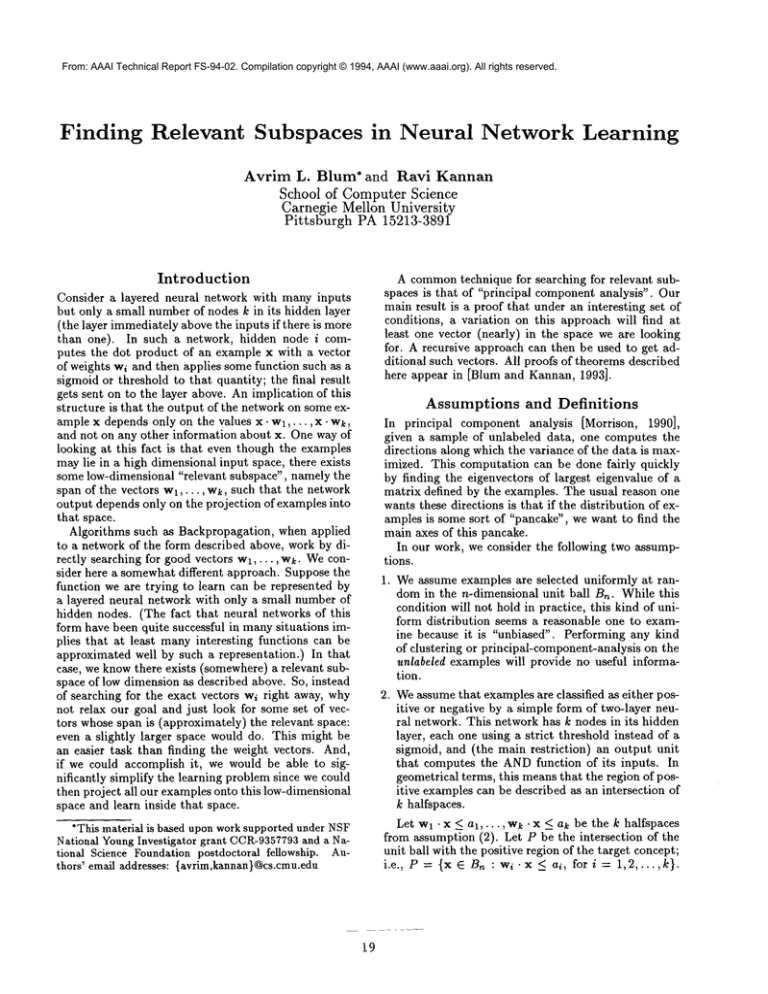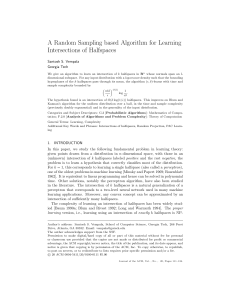
From: AAAI Technical Report FS-94-02. Compilation copyright © 1994, AAAI (www.aaai.org). All rights reserved.
Finding
Relevant
Subspaces
in Neural
Network
Learning
Avrim L. Blum* and Ravi Kannan
School of ComputerScience
C_arnegieMellonUniversity
PittslJurgh PA15213-3891
Introduction
A commontechnique for searching for relevant subspaces is that of "principal component analysis". Our
main result is a proof that under an interesting set of
conditions, a variation on this approach will find at
least one vector (nearly) in the space we are looking
for. A recursive approach can then be used to get additional such vectors. All proofs of theorems described
here appear in [Blum and Kannan, 1993].
Consider a layered neural network with many inputs
but only a small numberof nodes k in its hidden layer
(the layer immediately above the inputs if there is more
than one). In such a network, hidden node i computes the dot product of an example x with a vector
of weights wi and then applies some function such as a
sigmoid or threshold to that quantity; the final result
gets sent on to the layer above. An implication of this
structure is that the output of the network on someexample x depends only on the values x. wl,. ¯ ¯, x- wk,
and not on any other information about x. One way of
looking at this fact is that even though the examples
maylie in a high dimensional input space, there exists
some low-dimensional "relevant subspace", namely the
span of the vectors wl,. ¯ ¯, wk, such that the network
output depends only on the projection of examples into
that space.
Algorithms such as Backpropagation, when applied
to a network of the form described above, work by directly searching for good vectors Wl,..., wk. Weconsider here a somewhatdifferent approach. Suppose the
function we are trying to learn can be represented by
a layered neural network with only a small number of
hidden nodes. (The fact that neural networks of this
form have been quite successful in manysituations implies that at least manyinteresting functions can be
approximated well by such a representation.) In that
case, we knowthere exists (somewhere)a relevant subspace of low dimension as described above. So, instead
of searching for the exact vectors wi right away, why
not relax our goal and just look for some set of vectors whose span is (approximately) the relevant space:
even a slightly larger space would do. This might be
an easier task than finding the weight vectors. And,
if we could accomplish it, we would be able to significantly simplify the learning problem since we could
then project all our examplesonto this low-dimensional
space and learn inside that space.
In principal component analysis [Morrison, 1990],
given a sample of unlabeled data, one computes the
directions along which the variance of the data is maximized. This computation can be done fairly quickly
by finding the eigenvectors of largest eigenvalue of a
matrix defined by the examples. The usual reason one
wants these directions is that if the distribution of examples is some sort of "pancake", we want to find the
main axes of this pancake.
In our work, we consider the following two assumptions.
1. Weassume examples are selected uniformly at randomin the n-dimensional unit ball Bn. While this
condition will not hold in practice, this kind of uniform distribution seems a reasonable one to examine because it is "unbiased". Performing any kind
of clustering or principal-component-analysis on the
unlabeled examples will provide no useful information.
2.
Weassume that examples are classified as either positive or negative by a simple form of two-layer neural network. This network has k nodes in its hidden
layer, each one using a strict threshold instead of a
sigmoid, and (the main restriction)
an output unit
that computes the ANDfunction of its inputs. In
geometrical terms, this meansthat the region of positive examplescan be described as an intersection of
k halfspaces.
¯ This material is based upon worksupported under NSF
National YoungInvestigator grant CCR-9357793
and a National Science Foundation postdoctoral fellowship. Authors’ email addresses: {avrim,kannan}@cs.cmu.edu
Let wl -x < al,...,wk .x < ak be the k halfspaces
from assumption (2). Let P be the intersection of the
unit ball with the positive region of the target concept;
i.e., P = {x E Bn : wi ¯ x <_ ai, for i = 1,2,... ,k}.
Assumptions
19
and Definitions
Assumethat all the halfspaces defining the target concept are non-redundant in the sense that their removal
would enlarge P (otherwise, we could think of the target function as an even simpler network). Then, formally, the relevant subspace of P, denoted Vrel(P),
the span of the vectors wl,..., wk. The irrelevant subspace of P, denoted Virrel(P), is the collection of all
vectors orthogonal to Vrel(P). Vectors in Vrel(P)
called relevant vectors. A direction is a unit vector.
that case either Mmostall examples are positive or
almost all examples are negative.
Weconjecture that a theorem of this form extends
to the rest of the relevant subspace. In particular,
we conjecture that the vectors Vl,... ,vk where vl is
the center of gravity of P and vi is the unit vector
amongthose orthogonal to vl, ..., vi-1 that minimizes
ExEp[(vi. x)2], will span Vrel(P). Wealso conjecture
that vectors with a "noticeable" componentin an irrelevant direction will have noticeably higher second moment. If these conjectures are true, this wouldresult in
a simple polynomial time algorithm for approximating
the relevant subspace under assumptions (1) and (2).
In addition, it would give a simple polynomial-time
learning algorithm when k is a constant.
Although we cannot prove the above conjectures, using Theorem1 we are able to prove that a more complicated and less efficient strategy will learn in polynomial
time in a probably-approximately-correct sense under
assumptions (1) and (2) when k is constant, extending
results of [Baum, 1990]. The basic idea of the strategy is this: After finding the first relevant direction
as described above, look at "slices" perpendicular to
that direction, and recursively find a good hypothesis
for each slice. The idea here is that sufficiently thin
slices can roughly be treated as (n - 1)-dimensional
balls, with a (k - 1)-dimensional relevant subspace.
part due to the errors introduced in this approximation, the end hypothesis produced by our algorithm
will not be an intersection of halfspaces, but rather
a polynomial-time prediction algorithm representing a
union of hypotheses for each slice. The running time
and number of examples needed by this procedure are,
unfortunately, doubly exponential in k.
Results
It is not hard to see that given the assumptions (1)
and (2) above, if we draw a large sample and find that
the mean or center of gravity of the positive examples
is far from the center of gravity of the negative examples, then this difference gives us a vector (nearly)
in Vve1(P). (There will be some error due to sampling.) The reason this vector will approximately lie
in the relevant space is that P is symmetric about reflection through the hyperplane normal to any vector
v E Virrel(P). In other words, for any positive example
X -~- X p -~ Xirre I where Xirre I is the componentof x in
Vivrel(P), the example~ - xirrel is also positive. Our
main result is that if on the other hand these centers
of gravity are close, then the direction that minimizes
the second momentof the positive examples, or equivalently maximizes the second momentof the negative
examples, is also guaranteed to be (nearly) in the relevant space. This direction will not necessarily be any
of the vectors wi but rather may be some linear combination of them.
Formally, we prove the following theorem. Let p
denote the probability measure of P (the probability
of drawing a positive example). Say that a point x is
7.-central to a region R if a ball of radius 7. about x is
contained in R.
Remarks
Examplesin real learning scenarios are, of course, unlikely to be "selected at random from the unit ball".
Labelings are also unlikely to be completely consistent
with an intersection of a small number of halfspaces.
Nonetheless, we believe that our theorems regarding
these conditions shed some light on why examining
principal components can be a useful tool when neural networks are being considered. Wealso believe our
techniques should be extendible to cover more general
radially-symmetric distributions.
Theorem1 Let 7" be such that the origin is 7.-central
in P. Let v be the unit vector such that 2]
ExeP[(v .x)
is minimized, and w any other unit vector with t =
Ilproj (w, Virrei (P))I[. Then:
1. v ¯ Vrel(P)-
2. Ep[(w.x)z] > Ee[(v.x)z] +
t~n~
where A = P(8~) if p < --½, and A _-- (1-P)z(s-~2)
p
if
P>½.
Though Theorem 1 is a bit complicated to state, the
key point is the following. If the irrelevant portion
t of direction w is large, then the second momentin
direction w will be noticeably larger than the minimum
second moment,so long as 7- is not too small and p is
not too close to 0 or 1. It is not hard to showthat if the
mean of the positive examples is close to the mean of
the negative examples (the case where we would need
to apply this theorem) then 7" will not be too small.
Also, ifp is close to either 0 or 1, then it does not bother
us that we cannot find the relevant directions since in
References
E. B. Baum.Polynomialtime algorithms for learning neural nets. In Proceedingsof the Third AnnualWorkshopon
Computational Learning Theory, pages 258-272. Morgan
Kaufmann,1990.
A. Blum and R. Kannan. Learning an intersection of
k halfspaces over a uniform distribution. In Proceedings
of the 34 th Annual IEEE Symposiumon Foundations of
ComputerScience, pages 312-320, November1993.
D. F. Morrison.
Multivariate Statistical
McGraw-Hill,3rd edition, 1990.
2O
Methods.




